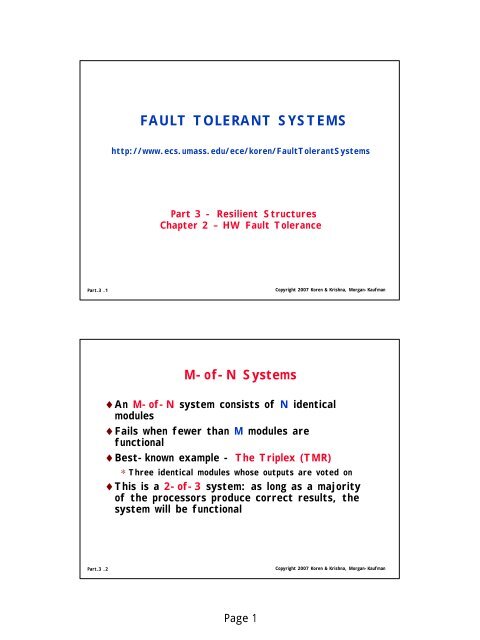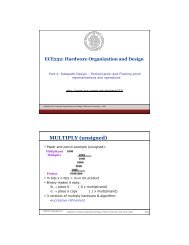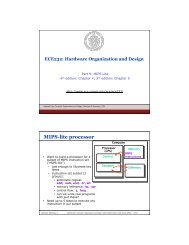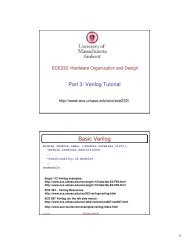FAULT TOLERANT SYSTEMS
FAULT TOLERANT SYSTEMS
FAULT TOLERANT SYSTEMS
Create successful ePaper yourself
Turn your PDF publications into a flip-book with our unique Google optimized e-Paper software.
<strong>FAULT</strong> <strong>TOLERANT</strong> <strong>SYSTEMS</strong><br />
http://www.ecs.umass.edu/ece/koren/FaultTolerantSystems<br />
Part 3 - Resilient Structures<br />
Chapter 2 – HW Fault Tolerance<br />
Part.3 .1<br />
Copyright 2007 Koren & Krishna, Morgan-Kaufman<br />
M-of-N Systems<br />
♦An M-of-N system consists of N identical<br />
modules<br />
♦Fails when fewer than M modules are<br />
functional<br />
♦Best-known example - The Triplex (TMR)<br />
∗ Three identical modules whose outputs are voted on<br />
♦This is a 2-of-3 system: as long as a majority<br />
of the processors produce correct results, the<br />
system will be functional<br />
Part.3 .2<br />
Copyright 2007 Koren & Krishna, Morgan-Kaufman<br />
Page 1
Reliability of M-of-N Systems<br />
♦N identical modules<br />
♦R(t) - reliability of an individual module<br />
♦The reliability of the system is the probability<br />
that N-M or fewer modules have failed by time<br />
t (or – at least M are functional)<br />
♦<br />
♦<br />
R<br />
♦<br />
♦where<br />
m−of<br />
−n<br />
( t)<br />
= (<br />
N<br />
i)<br />
(1 − R(<br />
t))<br />
N<br />
∑ − M<br />
i=<br />
0<br />
N<br />
= ∑<br />
i = M<br />
(<br />
)<br />
N i<br />
i<br />
R(<br />
t)<br />
(1<br />
( N N!<br />
) =<br />
i i!(<br />
N − i )!<br />
−<br />
i<br />
R(<br />
t)<br />
R(<br />
t))<br />
N −i<br />
N−i<br />
Part.3 .3<br />
Copyright 2007 Koren & Krishna, Morgan-Kaufman<br />
Correlated Failures in M-of-N<br />
Systems<br />
♦Key to the high reliability - statistical<br />
independence of failures in modules<br />
♦Correlated failure can greatly diminish reliability<br />
♦Example: q cor - probability that the entire<br />
system suffers a global failure<br />
N i<br />
Rm−of<br />
−n−cor<br />
( t)<br />
= (1−<br />
q cor ) ( ) R(<br />
t)<br />
(1−<br />
R(<br />
t))<br />
i<br />
N<br />
∑<br />
i = M<br />
N −i<br />
Part.3 .4<br />
Copyright 2007 Koren & Krishna, Morgan-Kaufman<br />
Page 2
M-of-N Systems - Modes of<br />
Correlation<br />
♦If system is not designed carefully, the<br />
correlated failure factor can dominate the<br />
overall failure probability<br />
♦Different modes of correlation among modules<br />
exist - not necessarily a global failure<br />
♦Correlated failure rates are extremely<br />
difficult to estimate<br />
♦From now on we will assume statistically<br />
independent failures in modules<br />
Part.3 .5<br />
Copyright 2007 Koren & Krishna, Morgan-Kaufman<br />
Reliability of TMR - Triple Modular<br />
Redundant Cluster<br />
♦M-of-N system with M=2, N=3 - system good if at<br />
least two modules are operational<br />
♦A voter picks the majority output<br />
♦Voter can fail - reliability of voter Rvot(t)<br />
♦<br />
♦<br />
♦<br />
R<br />
tmr<br />
1<br />
=<br />
3<br />
i<br />
( t)<br />
Rvot(<br />
t)<br />
∑ =<br />
( )(1<br />
− R(<br />
t))<br />
R(<br />
t)<br />
i 0 i<br />
3<br />
=<br />
3 i<br />
Rvot<br />
( t)<br />
∑ =<br />
( ) R(<br />
t)<br />
(1 − R(<br />
t))<br />
i 2 i<br />
♦ = Rvot(t) ( 3R² (t) - 2R³ (t) )<br />
3−i<br />
3−i<br />
Part.3 .6<br />
Copyright 2007 Koren & Krishna, Morgan-Kaufman<br />
Page 3
♦<br />
♦<br />
Reliability of TMR - Constant Failure<br />
Rates<br />
R(<br />
t)<br />
= e<br />
− λt<br />
♦ Assuming no voter failures - Rvot(t)=1<br />
R tmr<br />
( t)<br />
= 3e<br />
− 2λt<br />
− 2e<br />
− 3λt<br />
5<br />
MTTF<br />
1<br />
= MTTF<br />
∞ tmr = ∫ Rtmr<br />
( t)<br />
⋅dt<br />
= <<br />
6λ<br />
λ<br />
0<br />
simplex<br />
Part.3 .7<br />
Copyright 2007 Koren & Krishna, Morgan-Kaufman<br />
NMR - N-Modular Redundant Cluster<br />
♦M-of-N cluster with N odd and M = (N+1)/2<br />
♦Assume voter failure rate negligible - Rvot(t)=1<br />
♦Below R=0.5 - redundancy becomes a disadvantage<br />
♦Usually R >> 0.5 - triplex offers significant<br />
reliability gains<br />
Part.3 .8<br />
Copyright 2007 Koren & Krishna, Morgan-Kaufman<br />
Page 4
Compensating & Non-overalpping Faults<br />
♦Conservative assumption - every failure of voter<br />
leads to an erroneous output and any failure of<br />
two modules is fatal<br />
♦Counter Example - one module produces a<br />
permanent logical 1 and a second module has a<br />
permanent logical 0 - TMR will function properly<br />
∗ These are compensating faults<br />
♦A similar situation may arise regarding certain<br />
faults within the voter circuit<br />
♦Another example - non-overlapping faults - one<br />
module has a faulty adder and another module<br />
has a faulty multiplier<br />
♦If the circuits are disjoint, they are unlikely to<br />
generate wrong outputs simultaneously<br />
Part.3 .9<br />
Copyright 2007 Koren & Krishna, Morgan-Kaufman<br />
Voters<br />
♦A voter receives inputs X1, X2,...,XN from an<br />
M-of-N cluster and generates a representative<br />
output<br />
♦Simplest voter - bit-by-bit comparison of the<br />
outputs producing the majority vote<br />
♦This only works when all functional processors<br />
generate outputs that match bit by bit<br />
∗Processors must be identical, be synchronized<br />
and use the same software<br />
♦Otherwise - two correct outputs can diverge<br />
slightly, in the lower significant bits<br />
Part.3 .10<br />
Copyright 2007 Koren & Krishna, Morgan-Kaufman<br />
Page 5
Plurality Voting<br />
♦We declare two outputs X and Y as practically<br />
identical if |x-y| < d for some specified d<br />
♦A k-plurality voter looks for a set of at least<br />
k practically identical outputs, and picks any of<br />
them (or their median) as the representative<br />
♦Example - d = 0.1, five outputs<br />
♦1.10, 1.11, 1.32, 1.49, 3.00<br />
♦The subset {1.10, 1.11} would be selected by<br />
a 2-plurality voter<br />
Part.3 .11<br />
Copyright 2007 Koren & Krishna, Morgan-Kaufman<br />
Variations on NMR<br />
♦Unit-level<br />
Modular<br />
Redundancy<br />
♦Voters no longer critical - a single faulty voter is<br />
no worse than a single faulty unit<br />
♦The level of replication and voting can be lowered<br />
using additional voters - increasing the size and<br />
delay of the system<br />
Part.3 .12<br />
Copyright 2007 Koren & Krishna, Morgan-Kaufman<br />
Page 6
Triplicated Processor/Memory System<br />
♦All communications (in either direction) between<br />
triplicated processors and triplicated memories<br />
go through majority voting<br />
♦Higher reliability than a single majority voting of<br />
triplicated processor/memory structure<br />
Part.3 .13<br />
Copyright 2007 Koren & Krishna, Morgan-Kaufman<br />
Active/Dynamic Redundancy<br />
♦In previous examples - considerable extra hardware<br />
used to instantaneously mask errors<br />
♦In many cases, temporary erroneous results may be<br />
acceptable if<br />
∗system can detect an error<br />
∗replace the faulty module by a fault-free spare<br />
∗reconfigure itself<br />
♦This is called dynamic<br />
(or active) redundancy<br />
Example:<br />
Part.3 .14<br />
Copyright 2007 Koren & Krishna, Morgan-Kaufman<br />
Page 7
Reliability of Dynamic Redundancy -<br />
Powered Spares<br />
♦All N spare modules are active (powered) and have<br />
the same failure rate – resulting in a basic<br />
parallel system with N+1 modules<br />
♦System reliability is<br />
( t)<br />
= R<br />
dru<br />
( t)[1<br />
− (1−<br />
R(<br />
t) )<br />
R(t) - reliability of module<br />
Rdru(t) - reliability of Detection &<br />
Reconfiguration unit<br />
]<br />
N +!<br />
Part.3 .15<br />
Copyright 2007 Koren & Krishna, Morgan-Kaufman<br />
Dynamic Redundancy with<br />
Unpowered (Standby) Spares<br />
♦Spare modules are not powered (e.g., to conserve<br />
energy) and cannot fail until they become active<br />
♦C - coverage factor - probability that faulty<br />
active module is correctly diagnosed and<br />
disconnected, and good spare successfully<br />
connected<br />
♦Calculating exact reliability for the general case is<br />
complicated<br />
♦Reliability for a special case:<br />
∗ Very large N ; constant failure rate l per active module<br />
∗ Rate of nonrecoverable faults is (1-C)l<br />
∗ Reliability at time t - probability of no nonrecoverable<br />
R<br />
faults up to time t<br />
dynamic<br />
( t)<br />
= R<br />
dru<br />
( t)<br />
e<br />
−(1−c)λ<br />
Part.3 .16R dynamic<br />
Copyright 2007 Koren & Krishna, Morgan-Kaufman<br />
Page 8
Hybrid Redundancy<br />
♦NMR masks permanent and intermittent failures<br />
but its reliability drops below that of a single<br />
module for very long mission times<br />
♦Hybrid redundancy overcomes this by adding spare<br />
modules to replace active modules once they<br />
become faulty<br />
♦A hybrid system consists<br />
of a core of N processors<br />
(NMR), and K spares<br />
Part.3 .17<br />
Copyright 2007 Koren & Krishna, Morgan-Kaufman<br />
Hybrid Redundancy - Reliability<br />
♦Reliability of a hybrid system with a TMR core and<br />
K spares is<br />
R<br />
hybrid<br />
( t)<br />
= R<br />
vot<br />
( t)<br />
R<br />
rec<br />
m−1<br />
m<br />
( t)<br />
[ 1−<br />
mR(<br />
t)(1−<br />
R(<br />
t))<br />
− (1 − R(<br />
t))<br />
∗m=K+3 - total number of modules<br />
∗Rvot(t) and Rrec(t) - reliability of voter and<br />
comparison & reconfiguration circuitry<br />
∗Assuming: any fault in voter or comparison &<br />
reconfiguration circuit will cause a system fault<br />
♦In practice, not all faults in these circuits will be<br />
fatal: the reliability will be higher<br />
]<br />
Part.3 .18<br />
Copyright 2007 Koren & Krishna, Morgan-Kaufman<br />
Page 9
Sift-Out Modular Redundancy<br />
♦Like NMR all N modules are active but simpler<br />
than hybrid redundancy<br />
♦Comparing output of each module to outputs of<br />
other still operational modules<br />
∗ A module whose output disagrees with other is switched<br />
out<br />
♦Sift-out should not<br />
be too aggressive -<br />
most failures are<br />
transient<br />
♦Purge a module only<br />
if it produces<br />
incorrect outputs<br />
over a sustained<br />
period of time<br />
Part.3 .19<br />
Copyright 2007 Koren & Krishna, Morgan-Kaufman<br />
Page 10







